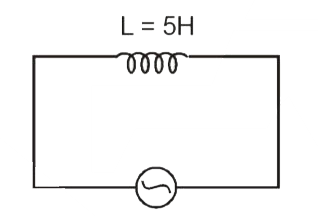An inductor L of inductance XL is connected in series with a bulb B and an AC source. How would brightness of the bulb change when
(i) number of turns in the inductor is reduced
(ii) an iron rod is inserted in the inductor and
a capacitor of reactance XC=XL is inserted in series in the circuit. Justify your answer in each case ?
The inductive reactance, XL=ωL
where, ω = angular frequency of AC source
L = inductance of the inductor.
The net resistance of the circuit is given by
Z=√X2L+R2
where, R = resistance of the bulb
(i) We know that, if the number of turns in the inductor decreases, then inductance L decreases. So, the net resistance of the circuit decreases and hence, the current through the circuit increases, increasing the brightness of the bulb.
(ii) If the soft iron rod is inserted in the inductor, then the inductance L increases. Therefore, the current through the bulb will decrease, decreasing the brightness of the bulb.
(iii) If the capacitor of reactance XC=XL is connected in series with the circuit, then
Z=√(XL−XC)2+R2
⇒ Z=R (∵XL=XC)
This is a case of resonance. In this case, the maximum current will flow through the circuit. Hence, the brightness of the bulb will increases.
Similar Questions
An inductor L of inductance XL is connected in series with a bulb B and an AC source . How would brightness of the bulb change when (i) number of turns in the inductor is increased (ii) an iron rod is inserted in the inductor and (iii) a capacitor of reactance XC=XL is inserted in series .
View SolutionA coil of self-inductance L is connected in series with a bulb B and an AC source. Brightness of the bulb decreases when
View Solution
Knowledge Check
A coil of self-inductance L is connected in series with a bulb B and an AC source. Brightness of the bulb decreases when
AFrequency of the AC source is decreasedBNumber of turns in the coil is reducedCA capacitance of reactance XC=XL is included in the same circuitDAn iron rod is inserted in the coilA coil of self-inductance L is connected in series with a bulb B and an AC source. Brightness of the bulb decreases when
ANumber of turns in the coil is reducedBA capacitance of reactance Xc=XL is included in the same circuitCAn iron rod is inserted in the coilDFrequency of the A.C. source is decresed
An inductor is connected in series with a bulb to an a.c source. What happens to brighness of bulb when number of turns in the inductor is reduced ?
View SolutionA bulb and a capacitor are connected in series to an a.c. source of varialbe frequency. How will the brightness of the bulb change on increasing the frequency of a.c. source ?
View SolutionA bulb and a capacitor are connected in series to an a.c. source of variable frequency. How will the brightness of the bulb change on increasing the frequency of a.c. source ?
View SolutionA bulb and a capacitor are connected in series to an a.c. source of variable frequency. How will the brightness of the bulb change on increasing the frequency of the a.c. source. Give reason.
View SolutionAn inductor of inductance L = 5 H is connected to an
AC source having voltage v = 10sin(10t+π6)
Find
Inductive Reactance (xL)

View SolutionA light bulb and an open coil inductor are connected to an ac source through a key as shown in Fig. The switch is closed and after sometime, an iron rod is inserted inot the interior of the inductor. The glow of the ligth bulb (a) increases (b) decreases (c) is unchanged as the iron is inserted. Give your answer with reasosns. What will be your answer if ac source is replaced by dc source ?

View Solution
